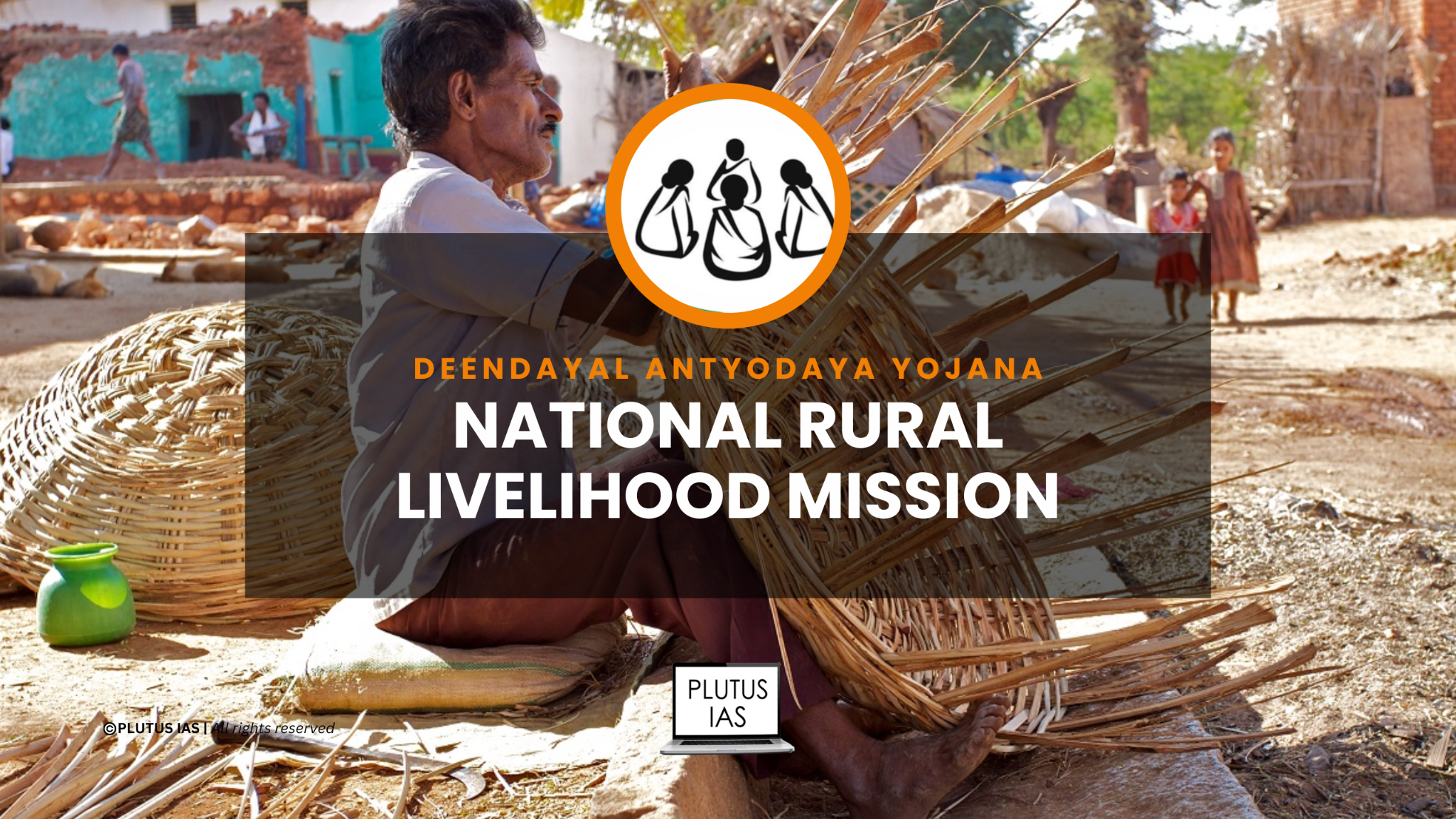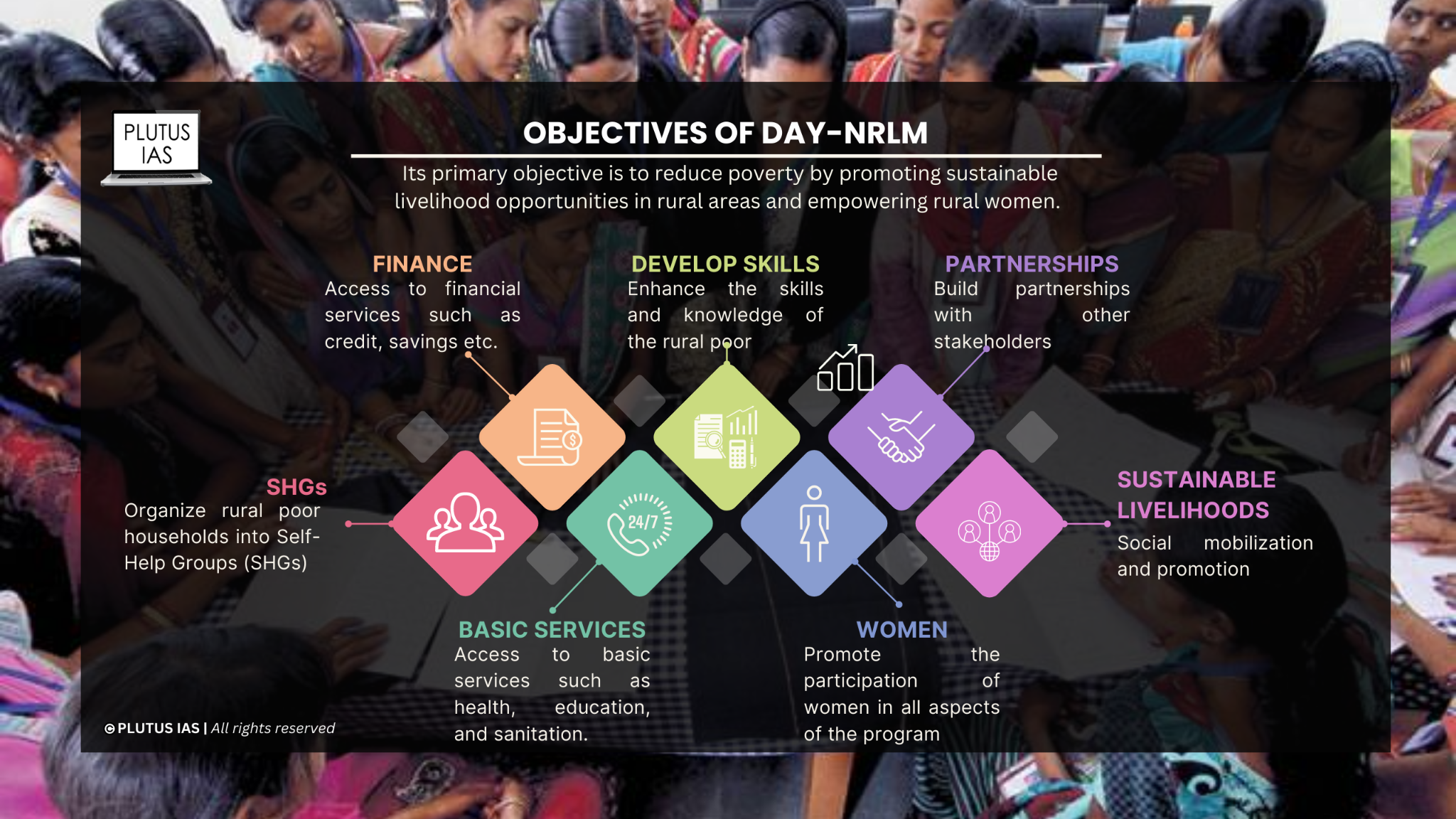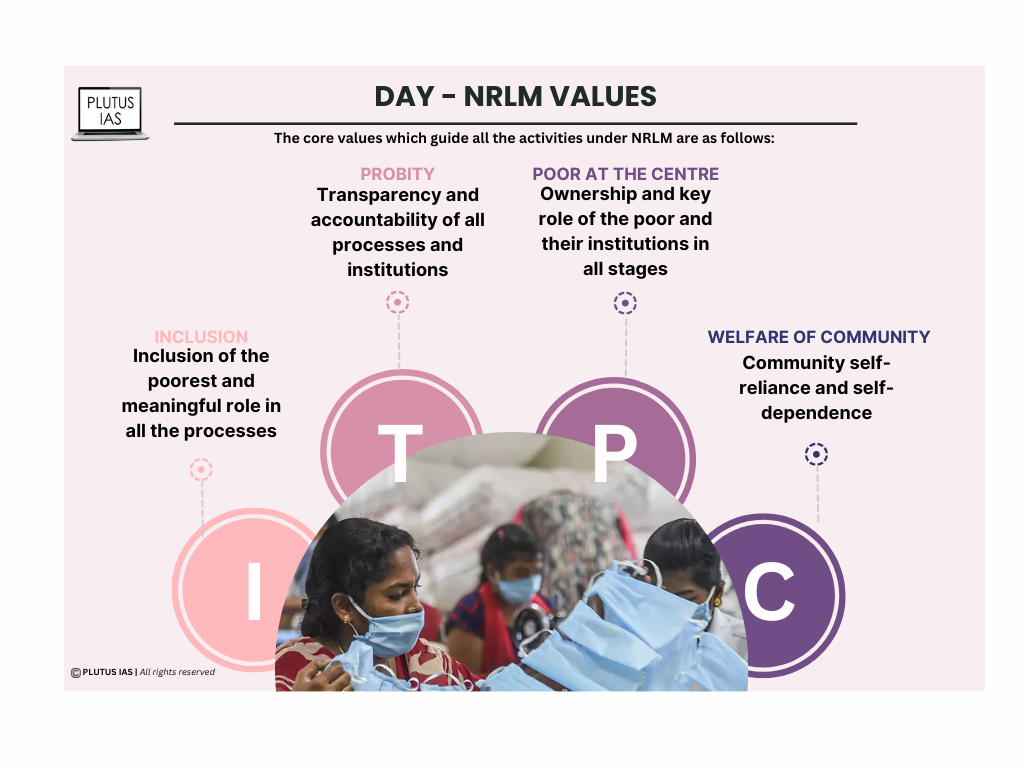04 Mar NATIONAL RURAL LIVELIHOOD MISSION
NATIONAL RURAL LIVELIHOOD MISSION (NRLM)
This article covers “Daily Current Affairs for UPSC” and the topic details the Deendayal Antyodaya Yojana – National Rural Livelihood Mission (Day-NRLM). The Ministry of Rural Development, Government of India has implemented a flagship program called DAY-NRLM to uplift the lives of people at the last mile by alleviating poverty.

NRLM Scheme
- For Prelims:
-
- Features of the Scheme
- Target beneficiaries
- Ministry implementing the Scheme
- For Mains: GS 2, Government Policies and Interventions for Development in various sectors and Issues arising out of their Design and Implementation.
-
-
- Performance of the Scheme
- Issues related to the implementation of the scheme
-
Solutions for successful implementation of the NRLM scheme.
CONTENTS:
- Why in the news?
- Objectives of the Scheme
- Core Values of the Scheme
- Features of the Scheme
- Status of the Scheme
- Issues related to the implementation of the scheme
- Solutions for successful implementation of the scheme
- Way Forward
Why in the news?
Recently, DAY-NRLM organized a CSR conclave with Corporates for synergizing efforts at the grassroots
Objectives of the NRLM Scheme
Its primary objective is to reduce poverty by promoting sustainable livelihood opportunities in rural areas and empowering rural women. The specific objectives of DAY-NRLM are:

Day-NRLM
- Organize rural poor households into Self-Help Groups (SHGs) and their federations for improving their social and economic status.
- To provide them with access to financial services such as credit, savings, insurance, and pension.
- To enhance the skills and knowledge of the rural poor and provide them with support services to improve their livelihoods.
- To ensure that the rural poor have access to basic services such as health, education, and sanitation.
- To promote the participation of women in all aspects of the program, including decision-making.
- To build partnerships with other stakeholders, including government departments, civil society organizations, and private sector institutions, to promote rural development.
The Mission seeks to achieve its objective through investing in four core components viz.
(a) Social mobilization and promotion and strengthening of self-managed and financially sustainable community institutions of the rural poor women;
(b) Financial inclusion;
(c) Sustainable livelihoods; and
(d) Social inclusion, social development, and access to entitlements through convergence.
Core Values of the Scheme

NRLM scheme
NRLM is guided by some values.
Features of the NRLM Scheme
Some of the features of NRLM are:
- Target Group: NRLM primarily targets the rural poor, particularly women, Scheduled Castes (SC), Scheduled Tribes (ST), and other vulnerable sections of society.
- Self-Help Groups (SHGs): NRLM promotes the formation of SHGs at the village level. These groups comprise 10-20 members, predominantly women, and operate on the principle of mutual trust and support.
- Community-based Organizations (CBOs): NRLM also promotes the formation of CBOs, such as Village Organizations (VOs) and Cluster Level Federations (CLFs), to provide institutional support to the SHGs.
- Financial Inclusion: NRLM aims to promote financial inclusion among the rural poor. It provides support to SHGs to open bank accounts, avail of loans, and access other financial services.
- Livelihoods Promotion: NRLM supports the livelihoods of the rural poor through various activities such as skill development, entrepreneurship promotion, and market linkages.
- Convergence: NRLM promotes convergence with other government programs and schemes such as MGNREGA, PMAY, and Swachh Bharat Abhiyan.
- Capacity Building: NRLM provides training and capacity-building support to the SHGs and CBOs to enhance their skills and capabilities.
- Monitoring and Evaluation: NRLM has a robust monitoring and evaluation framework to track the progress and impact of the program.
Status of the Scheme
The program has made significant progress in reducing poverty and empowering rural communities since its inception. According to the Ministry of Rural Development, over 6.3 crore rural households have been mobilized under the program and over 4.6 crore women have been empowered through the formation of Self-Help Groups (SHGs).
The program has also helped to increase access to credit for the rural poor, with over 4.4 crore SHGs accessing bank loans amounting to over Rs. 1.73 lakh crore. In addition, the program has helped to build the capacity of over 6 lakh community resource persons and provided them with training on various livelihoods and financial inclusion-related topics.
Issues related to the implementation of the scheme
Some of the issues related to the implementation of the NRLM are
- Limited reach and awareness: The NRLM has not been able to reach all the poor households in rural areas due to poor implementation and inadequate resources. Many of the targeted beneficiaries are not aware of the program or how to access its benefits, which limits the program’s impact.
- Lack of training: Many of the community resource persons (CRPs) responsible for implementing the NRLM have not received adequate training, which affects the quality of their work and the outcomes of the program.
Low awareness: Limited financial resources: The NRLM has limited financial resources, and limits its ability to provide support to all eligible households.
- Gender bias: Despite the program’s focus on empowering women, there are still gender biases in the implementation of the NRLM, particularly in terms of access to credit and decision-making.
- Inadequate monitoring: There is a lack of adequate monitoring and evaluation of the program, which makes it difficult to track its progress and identify areas for improvement.
Solutions for successful implementation of the scheme
To ensure the successful implementation of the National Rural Livelihoods Mission (NRLM) in India, some possible solutions are
- Increase the reach of NRLM: The NRLM should be expanded to touch all vulnerable sections of the population.
- Create awareness: There is a need to create awareness about the program among targeted beneficiaries through targeted outreach and communication campaigns.
- Ensure proper training: There is a need to appropriately train both the community resource persons (CRPs) and the beneficiaries.
- Addressing gender biases: The program has women at the core, therefore there is a need to provide them with equal access to credit, resources, and decision-making opportunities.
- Strengthening monitoring and evaluation mechanisms to track progress, identify gaps, and improve the program’s effectiveness.
- Encouraging convergence and collaboration among various stakeholders such as government agencies, NGOs, and local communities to leverage resources and achieve common goals.
- Use of Technology: Encouraging the use of technology and digital platforms to streamline the implementation process, improve transparency, and enhance accountability
Way Forward
Overall, the NRLM needs to be an integrated and comprehensive program that addresses the diverse needs of the rural poor and is sustainable, resilient, and scalable. To achieve this, a multi-stakeholder approach, effective implementation, and robust monitoring and evaluation mechanisms are essential.
Source:
Daily Current Affairs for UPSC
The topic described above is based on Indian Polity and Governance which is related to daily current affairs for UPSC. The article talks about the details of the National Rural Livelihood Mission (Day-NRLM). Get such kinds of the best daily current affairs related to Indian Polity and Governance for the UPSC Examination. Also, Read weekly and monthly current affairs today for IAS exam preparation.
Download the PDF now:



No Comments